When ensuring the health, safety, well-being and education of children and their families, educators must comply with regulatory and legislative requirements by the national and state/territory government bodies. It is also an expectation that services work within a best practice model, where they operate in line with relevant codes, conventions, and guidelines for the industry.
By the end of this topic, you will understand:
- The National Quality Framework and the National Quality Standard
- How to facilitate the assessment and rating process
- How to prepare for the assessment and rating visit.
Services will ensure that they provide staff with information and training to support them in understanding and implementing the NQF, legislation and regulations.
In 2012, all Australian governments began collaborating to provide higher educational and developmental outcomes for children, introducing the National Quality Framework (NQF). The NQF should be instilled into long day care, family day care, preschools, kindergartens and outside-school-hours care (OSHC). Its objective is to drive continuous improvement in these settings as well as a consistent approach, utilising:
- National Law and Regulations
- The National Quality Standard
- An assessment and quality rating process
- National approved learning frameworks
- The regulatory authority in each state/territory responsible for the approval, monitoring and quality assessment of services in their state/territory
- The Australian Children’s Education and Care Quality Authority (ACECQA), which is a national body that guides the implementation of the NQF and works with regulatory authorities
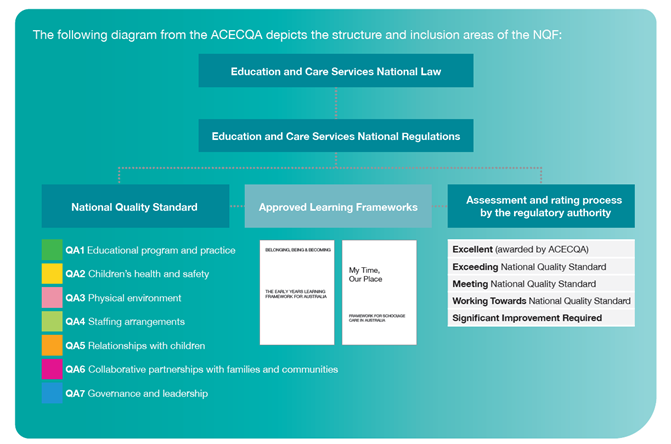
The objectives of the NQF are to:
- ensure the safety, health and well-being of children attending education and care services and improve the educational and developmental outcomes for children attending education and care services
- promote continuous improvement in the provision of quality education and care services
- establish a system of national integration and shared responsibility between participating jurisdictions and the Commonwealth in the administration of the National Quality Framework
- improve public knowledge and access to information about the quality of education and care services
- reduce the regulatory and administrative burden for education and care services by enabling information to be shared between participating jurisdictions and the Commonwealth.
The ACECQA guides the implementation of the NQF and works with regulatory authorities. It provides resources, advice, consultation, and support for services implementing the NQF. ACECQA is the national authority. They work with the Australian and state and territory governments such as the Department of Education, Department of Health, Department of Social Services and Department of Human Services to:
- implement changes that benefit children birth to 13 years of age and their families
- monitor and promote the consistent application of the Education and Care Services National Law across all states and territories
- support the children’s education and care sector to improve quality outcomes for children.
Resource
To find out more about national and state regulatory bodies, review these links:
State-based regulatory bodies provide approvals for services, monitor their progress and regulations, and manage the quality assessment process. Read more for a directory of the different state-based regulatory bodies in Australia: Contact Your Regulatory Authority from the ACECQA.
There is also a range of non-government services that can provide assistance and compliance support resources, including:
- Community Connections Solutions Australia
- Early Childhood Australia (ECA)
- Early Childhood Teachers Association
- Early Childhood Association Australia
- Australian Childcare Alliance
Resource
To find out more about the non-government bodies that can assist services with information and support, go to the ACECQA website.
The Education and Care Services National Law Regulations
The Education and Care Services National Law (National Law) and the Education and Care Services National Regulations (National Regulations) detail and apply the operational and legal requirements for an education and care service.
The National Regulations are a practical document detailing how to implement the National Law into a service. It leads and directs practice.
Watch the clip to learn more about ACECQA and regulatory authorities: Topic 13: What Is the Role of ACECQA and Regulatory Authorities? by ACECQA on YouTube: 3:29 minutes.
Activity 2A
Navigating the National Regulations
Review the National Regulations: Education and Care Services National Regulations (2011 SI 653) from New South Wales Legislation.
For each of the listed areas, describe what they would require in practice and the consequences for not meeting the requirements:
- E81 Sleep and rest
- E89 First aid kits
- E99 Children leaving the education and care service premises
- E118 Educational leader
Ensure that you keep notes for future reference, as this information will support your assessment and professional practice.
The National Quality Standard
The National Quality Standard (NQS) guides all aspects of a service’s operations. It sets a benchmark for high-quality services in seven areas. Regulatory authorities assess and rate services using the seven areas to produce an overall performance rating.
Standards, policies, and procedures of a service will link to each one of the standards in the National Quality Framework:
- Collaborative partnerships with families and communities
- Educational programs and practices
- Health and safety
- Staffing arrangements
- The physical environment
- Relationships with children
- Governance and leadership
Watch the video to learn about the National Quality Standard: Topic 3: What Is the National Quality Standard? by ACECQA on YouTube: 2:51 minutes.
Activity 2B
Navigate the NQS
Read through the NQS handout.
Download and complete the detail in the template table: Navigate the NQS
This table describes the nationally approved learning frameworks:
| Approved Learning Framework | Description | |
|---|---|---|
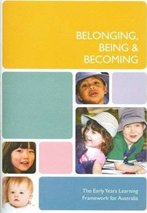 |
Belonging, Being & Becoming: The Early Years Learning Framework for Australia (EYLF) |
The EYLF is Australia’s first national early years learning framework for early childhood educators, assisting them in providing young children with opportunities to maximise their potential and develop a foundation for future success in learning. The framework was made to extend and enrich children’s learning from birth to five years and through the transition to school. |
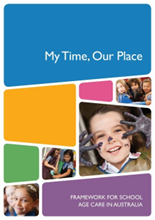 |
My Time, Our Place: Framework for School Age Care in Australia (MTOP) |
This framework is linked to the EYLF, Australia’s first nationally used framework for school-age care. It has been designed for use by school-age care educators working in partnership with children, their families, and the community, including schools. It aims to extend and enrich children’s well-being and development in school-age care settings. |
| Specific state frameworks | ||
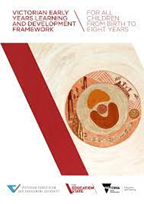 |
Victorian Early Years Learning and Development Framework: For All Children from Birth to Eight Years (VEYLDF) |
The VEYLDF guides early childhood professionals to collaborate with families in support of their children. The framework embraces and responds to the cultural and linguistic diversity of the Victorian community and their diverse approaches to child-rearing. The framework has been made to guide early childhood professionals toward achieving the nationally agreed EYLF Learning Outcomes with the amalgamation of the Victorian Curriculum F–10 (the first three levels). |
 |
Western Australia: Curriculum Framework for Kindergarten to Year 10 | The Western Australian (WA) curriculum framework covers kindergarten to year 10, with prescribed content and standards for program planning, learning, assessment, and communication reports to families. The framework encompasses English, mathematics, science, humanities, social science, physical education, the arts, language, and technology studies, all contextualised to meet the needs of the WA communities. |
Resource
You can find the full versions of the approved learning frameworks at Approved Learning Frameworks from the ACECQA.
Belonging, Being and Becoming
In this diagram from Belonging, Being and Becoming5, you can see that the framework places children’s learning at its core and comprises three interrelated elements: principles, practice and learning outcomes. These elements are fundamental to early childhood pedagogy and curriculum decision-making.
Principles:
- Secure, respectful and reciprocal relationships
- partnerships with families
- high expectations and equity
- respect for diversity
- ongoing learning and reflective practice
Practice:
- Holistic approach
- responsiveness to children
- learning through play
- intentional teaching
- learning environments
- cultural competence
- continuity of learning and transitions
- assessment for learning
Learning outcomes:
- Children have a strong sense of identity
- connected with and contribute to their world
- have a strong sense of wellbeing
- are confident and involved learners
- are effective communicators
Watch
View this clip to learn about Aboriginal and Torres Strait Islander people’s perspectives on the use of Belonging, Being & Becoming: ‘Belonging, Being and Becoming by Queensland Department of Education on YouTube: 6.34 minutes
Watch Part 1 of Environments for Belonging, Being and Becoming from the series Talking About Practice by ECA Learning Hub on YouTube: Part 1 - https://www.youtube.com/watch?v=b9Qw9j9v1ss 10.34 minutes
If you would like to watch the rest of Environments for Belonging, Being and Becoming, visit these links:
- Part 2: https://www.youtube.com/watch?v=qYKETiGcMCE 8.59 minutes
- Part 3: https://www.youtube.com/watch?v=bHbVYCfGMQ0 21.18 minutes
- Part 4: https://www.youtube.com/watch?v=PTw_c59Jw-U 5.05 minutes
Resource
You can read the EYLF in full at Belonging, Being & Becoming: The Early Years Learning Framework for Australia.
Think
Reflect on and make notes about your sense of belonging, being and becoming in the current moment. For example, do you feel you ‘belong’ to a place/group or the world? Why? What do you think about your sense of ‘being’ in this current moment? How do you practice being in the moment? What are you curious about?
How are you working towards ‘becoming’? Do you have goals to improve your work-life balance or reach career aspirations? How do you picture yourself in the future?
Learning Outcomes
The EYLF describes a learning outcome as ‘a skill, knowledge, or disposition educators can actively promote in early childhood settings, in collaboration with children and families’.
The framework provides a broad direction for educators to facilitate learning for children and guides educators in their program decision-making, implementation, and evaluation.
The Framework conveys the highest expectations for all children’s learning from birth to five years and through the transitions to school. It communicates these expectations through the five Learning Outcomes:
- Children have a strong sense of identity
- Children are connected with and contribute to their world
- Children have a strong sense of wellbeing
- Children are confident and involved learners
- Children are effective communicators. EYLF6
Pedagogy
Often referred to as ‘the art of teaching’, ‘pedagogy’ is a term that encompasses the holistic nature of early childhood educators’ professional practice, relationship building, curriculum decision-making and use of relevant developmental and teaching/learning knowledge, experience, theories, and research.
When educators establish respectful and caring relationships with children and families, they are able to work together to construct curriculum and learning experiences relevant to children in their local context. These experiences gradually expand children’s knowledge and understanding of the world.EYLF7
Your pedagogies will be your strategies or methods when implementing the curriculum and how you make decisions. They might include:
- The importance of allowing time for extended play experiences
- Critical reflection techniques
- Beliefs on the importance of meeting health, safety and comfort needs before learning can occur
- The understanding of each child in the context of their social and cultural world
- The development of genuine, trusting relationships with both the children and their families.
Resources
To learn more about pedagogy for the EYLF, visit What Is Pedagogy? How Does It Influence Our Practice?
Perspectives on Pedagogy from the Government of South Australia Department of Education and Child Development.
The principles underpin practice that is focused on assisting all children to make progress in relation to the Learning Outcomes.EYLF8
Principles and Practices
The principles, practice statements and learning outcomes do not work in isolation. They are interconnected and based on research and are a part of the holistic practice of the EYLF.
The EYLF and MTOP share the same five principles:
- Secure, respectful and reciprocal relationships
- Partnerships
- High expectations and equity
- Respect for diversity
- Ongoing learning and reflective practice

The principles of early childhood pedagogy underpin practice and promote learning. The pedagogical practices featured in the frameworks are based around:
- Holistic approaches – Recognising how children’s physical, personal, social, emotional, and spiritual well-being, as well as cognitive aspects of learning, are connected
- Responsiveness and collaboration with children – Valuing, building on and responding to children’s ideas, strengths, skills, and knowledge to encourage motivation and engagement in learning, their well-being and shared decision-making
- Learning through play – Planning and implementing play and leisure activities
- Intentional teaching – Acting with intention
- Appropriate learning environments – Creating physical and social school-age care environments that have a positive impact on children’s development and well-being, and community building
- Cultural competence – Valuing the cultural and social contexts of children and their families
- Continuity of learning and transitions – Connecting with a child’s family and community to encourage ways of being, belonging and becoming, building upon pre-existing experiences to ensure confidence, inclusion, and security for the child
- Assessment and evaluation of children’s learning – Using reflection and documentation on children’s well-being and learning to inform and evaluate programs and to support children in achieving outcomes
Watch
Watch these videos on practice principles by the Department of Education and Training, Victoria, on YouTube:
The Practice Principles 1 of 2:
The Practice Principles 2 of 2:
VEYLDF Practice Principles – Reflective Practice:
VEYLDF Practice Principles – High Expectations for Every Child:
Activity 2C
Learning outcomes, pedagogy, and practices
Read this scenario and list one (1) possible learning outcome for Linh in the table provided:
Linh
Linh is four years old and has just returned to the service after the summer holidays. After scanning the room, she walks directly to the sand trough, puts shells all along the side, and gathers three small world people from the shelf beside it. She bounces the people up and down the sand, giggling and laughing. Then, she turns to the educator and says, ‘Can I add water? On my holiday at the beach, there was water. See, this is my dad, my mum and me, and we are playing at the beach, having so much fun!’
Download and complete the Learning Outcomes and Pedagogy worksheet
Every service will also have documented standards, policies, and procedures that link to each one of the standards in the National Quality Framework:
- Collaborative partnerships with families and communities
- Educational programs and practices
- Health and safety
- The physical environment
- Relationships with children
- Governance and leadership.
Contemporary Principles and Emerging Trends
The early childhood industry has continued to develop and evolve, especially with patterns of usage changing with more children entering early childhood services as both parents are working. In addition, since the introduction in 2012 of the NQF. There has been an increased focus on improving outcomes for children using services.

Some current trends in children’s services include:
- Use of technology in learning, including technology in the classroom and remote learning options using technology to allow accessibility (following the COVID pandemic in 2020 and the need for service shutdowns and home-schooling)
- Emergent curriculum where learning takes into consideration the needs and interests of children and forms learning that is based on their strengths and interests
- Using natural environments and outdoors to enhance learning
- Professionalising the early childhood workforce and obtaining professional recognition of workers
- Recognising the overall importance of the early years as a key learning environment for children.
Data is also maintained on the changing patterns of service providers and service types overall and by state/territory and measuring rating outcomes and whether they are improving.
Some statistics from the most recent service snapshot by ACECQA9include:
- Changes in the number of services in Australia, e.g., Victoria experienced a 13% increase in family day-care and a 6% increase in centre-based care
- Quality ratings, e.g., 27% of total services, exceed NQS quality ratings in the second quarter of 2022.
- Quality ratings, e.g., over 30% of services exceeding the NQS quality ratings, did so in all seven areas.
- Percentage of services in Australia per type, e.g., NSW has approximately 5800 services and is the state with the highest number, while the Northern Territory has only 225 total providers.
- Number of services by type, e.g., private for-profit providers cover 21% of all providers while schools (combined) have 8% of services.
Educators can use problem-solving skills to identify deficiencies in information and address these by conducting ongoing searches. When researching information, educators will seek authoritative guidance on research to ensure the quality, credibility, and reliability of sources.
A checklist that can be used to confirm credibility would include the following evaluation criteria:
- authenticity
- balanced nature of the information presented, e.g., not a stereotyped or generalised, positive portrayal
- accuracy and support, e.g., up to date and correct.
Educators can meet deficits in information to build their development and knowledge by collaborating with the regulatory authority, non-government sources and peak agencies.
Resource
To can use research to find out more about changes in the childcare sector by referring to ACECQA, State of the Sector report, which provides a snapshot of services and changes in annually periods.
To find out more about proposed strategies for children’s services, refer to the National Children’s Education and Care Workforce Strategy, Shaping Our Future, a ten-year strategy to ensure a sustainable, high-quality children’s education and care workforce 2022-2031.
Using Critical Reflection

Reflection involves thoughtful and analytical thinking focused on improving the educator’s practice. It provides a platform for educators to think openly and analytically about key topics or questions that are the focus of the reflection. The insight educators and other staff gain during critical reflection can improve the quality of the service's practice. Reflection enables open discussion of success and identification of areas for improvement.
Critical reflection assists educators in identifying areas of development and provides an opportunity to build their knowledge and skills. It should be conducted regularly to explore the educators’ thoughts, feelings, and experiences. It is valuable for extending and refining professional practice and informing future development.
Educators use critical reflection to identify the need to acquire new knowledge and make positive changes to practice. Educators review beliefs and practices using questioning and assessment to make decisions that will enhance future practices.
Meaningful reflection occurs when quality information is gathered in response to key questions about what has occurred and why.
Meaningful reflection includes:
- thoughtfully exploring different aspects of a topic, including:
- the reasons that decisions were made
- whether and how the service's philosophy is reflected in the decision or practice
- what were the outcomes of the decision or practice?
- thoughtfully considering a range of perspectives on a topic, including the way that practices impact children and families
The Assessment and Rating of Services
Services are assessed and rated by their regulatory authority against the NQS.
The service will be assessed and rated in each of the seven quality areas and receive an overall service rating. These ratings must always be displayed at the service per national regulation 173. Services still waiting to be assessed are given a rating of ‘Provisional—Not yet assessed under the National Quality Framework’, which must also be displayed at the service.
Services can be rated as:
- Significant improvement required
- Working towards National Quality Standard
- Meeting National Quality Standard
- Exceeding National Quality Standard
- Excellent
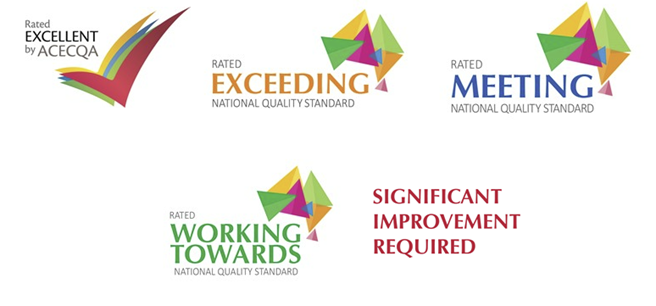
Images sourced from Starting Blocks
Services will ensure that they share information with all staff so they know their requirements under the assessment and rating process. This can include staff development opportunities and meetings discussing the assessment and rating process. Services will also involve staff to build their knowledge and understanding.
Self-assessment and quality improvement
Resources
To find out more about the assessments and rating system, visit the Starting Blocks
Service ratings are published for transparency to the public. You can search for specific services to see their rating at these links:
The ACECQA10 website summarises the steps in the rating and assessment process. The process sets out the steps an approved provider will take to self-assess the quality of their current practices against the National Quality Standard and regulatory requirements.
|
The approved provider identifies strengths and areas for improvement on an ongoing basis. Notice of the start of the process (week 1) The regulatory authority provides written notice to an approved provider that the assessment and rating process has commenced. Quality improvement plan (week 3–4) The quality improvement plan is submitted to the regulatory authority before the visit, along with any additional information requested by the regulatory authority. Visit (week 5 to 8) The regulatory authority visits the service. Feedback on draft report (3–5 weeks after the visit) The regulatory authority provides the approved provider with a draft assessment and rating report. The provider can give feedback on any factual inaccuracies in the report and evidence to support feedback. Final report and notice of final ratings issued to the provider Feedback is considered before the final report is finalised and issued. The approved provider may apply for a review of final ratings within the set review period. Ratings published Once the review period has ended, the final ratings are published on the national registers.10 |
Resources
Read about the service assessment process at Assessment and Rating Process from ACECQA
Self-Assessment
The self-assessment process is an important part of the quality improvement process. It is addressed by NQS Element 7.2.1, which states that a service must have ‘an effective self-assessment and quality improvement process in place’.
The self-assessment process requires a service to reflect on and assess their strengths and weaknesses against the National Quality Standard. Accordingly, the ACECQA devised a self-assessment tool to support services by evaluating whether their policies, procedures and practices align with the NQS, National Law and National Regulations. The ACECQA also produced the following diagram to demonstrate the self-assessment process:
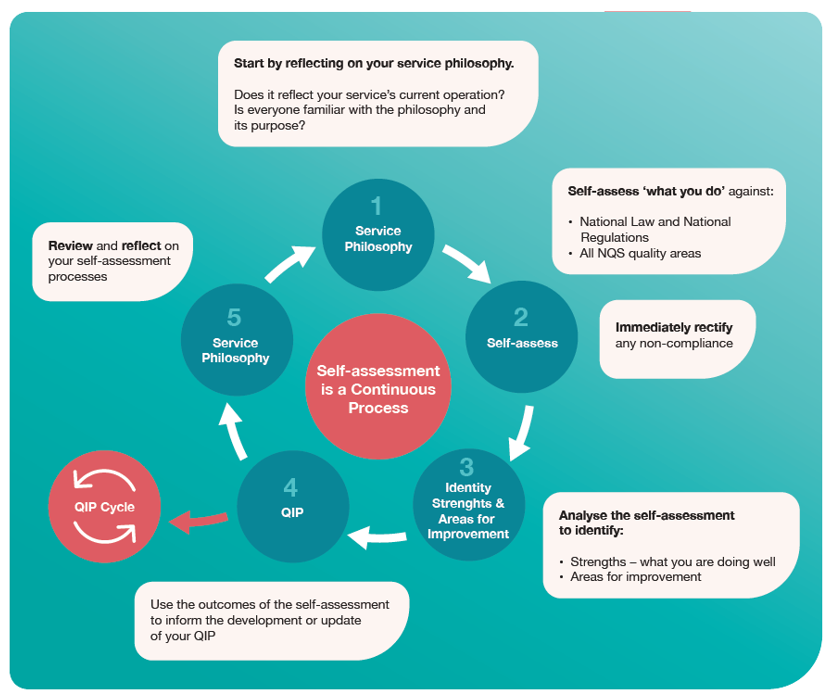
The self-assessment tool is an optional (non-compulsory) resource for services that can help support and inform their quality improvement plan. It lists several reflective questions to be posed regarding each NQS standard:
What practices do we implement that demonstrate this standard?
- How are our practices improving outcomes for children and families?
- How do we demonstrate that our practice is typical for our service?
- How do/could we articulate what informs our practice?
- How do we engage with families and/or the community?
- What, if any, are the areas where we need to take immediate action?
- What are the opportunities for quality improvement? ACECQA Self-Assessment Tool11
Services need to build rapport with children, families, and the community to interact and engage with them. Rapport is fostered through genuine and trust-based relationships. These aid in relationship building. To build rapport, educators will explore children, family and community members’ preferences and interests and find common interests to establish common ground. Establishing trusting relationships is the basis for building future positive interactions and communication.
Sharing information with children, families, and the community enables the service to engage them in the self-assessment process. They can be invited to contribute, provide feedback, and be involved in the process. These practices further build collaborative partnerships with stakeholders.
Staff also can be involved in the process of self-assessment. This can occur at team meetings, staff development, review of policies and practices and conducting surveys. Services can share ideas with staff during self-assessment.
Services can make self-assessment data available to stakeholders to facilitate informed discussions on the process and ratings.
Resources
You can download the ACECQA self-assessment tool
Watch
Watch these videos to learn more about self-assessment and improving practices: Continuous Improvement in Practice by ACECQA on YouTube:
Self-Assessment, Reflective Practice and Quality Improvement Processes by ECA Learning Hub on YouTube:
Think
The self-assessment tool has many tips and ideas for action and critical reflection.
Review section 5 (‘Who self-assesses?’, pages 11–13) and reflect on the following questions:
- How would you personally encourage or engage in this feedback and process?
- How could you collect and document the necessary information?
- How could you create an ongoing cycle for assessment?
Activity 2D
Honestly assessing a service
Review the following images and make considered assumptions about what is happening in them. Assess the situations using Quality Area 3 – Physical Environment (refer to pages 39–44) in the ACECQA self-assessment tool (standards)
Ensure that you keep notes for future reference, as this information will support your assessment and professional practice.
The Quality Improvement Plan (QIP)
The QIP is the primary document utilised during the rating and assessment process. It is an ongoing cycle demonstrating how a service strives further towards excellence. The QIP should use the information from the self-assessment as support and guidance to inform the plan.
Services will ensure that they consult with stakeholders and collaborate widely to identify strengths and key improvement areas through self-assessment and the development of the QIP. The collaboration involves children, families, educators, staff members, management, and other interested parties. It can also involve representatives of community agencies and community members engaged with the service. This information will be recorded in the QIP.
There is no compulsory format, nor do you have to cover all quality areas of the NQS at once, but it must point out the key improvement areas specified by the stakeholders. Services may have a template that can be used to record the report. Educators will seek assistance from management to ensure they are using the approved proforma report template. The recording of the QIP will follow the services policies and procedures, such as a style guide that dictates format, branding, language style and tone. Policies may also include naming and storage requirements to ensure ease of retrieval and confidentiality. The plans will be recorded using digital media such as computer technology and software to create, edit and store the plans.
The aim of a QIP is to help providers self-assess their performance in delivering quality education and care, and to plan future improvements.ACECQA12
National regulations 31, 55 and 56 all centre around the quality improvement plan, requiring that:
- All new services develop a QIP within three months of the service approval being granted and provide it to its regulatory authority on request
- The QIP is kept available for the regulatory body
- The QIP is updated annually or when directed by the regulatory authority to do so (as an ongoing cycle of demonstrated improvement)
The services ensure that stakeholder collaboration occurs regularly to review the QIP. This might include stakeholder meetings, circulated information on actions achieved on the plan, surveys and invitations to provide feedback on the plan and suggestions and ideas for improving the plan. At a minimum, the review of the QIP occurs annually when it is required by the regulations to be updated.
The QIP includes:
- An assessment of the programs and practices at the service against the National Quality Standard and National Regulations
- Identified areas for improvement
- The service’s philosophy
- Documented proof of the service’s strengths
Activity 2E
Developing a QIP
Reflecting on your self-assessment and the images from Learning Activity 2D, use the QIP template at the link provided to document key strengths and improvement areas of the service regarding Quality Area 3 – Physical Environment (refer to pages 39–44) from the ACECQA self-assessment tool: Quality Improvement Plan from the ACECQA

ACECQA administers the quality rating reliability assurance program. Some authorised officers are the assessor or field officer appointed by the regulatory authority. They are responsible for conducting the assessment and rating visits. They receive training from AECECQA about their specific functions under the National Law and Regulations to assess, rate, monitor compliance and investigate incidents in early education and care services.
ACECQA developed a tool named the National Quality Standard Assessment and Rating Instrument. Initially designed for authorised officers, this tool is now accessible to services to help them prepare for the visit.
Authorised officers use the tool to:
- Prepare for the assessment and rating visit
- Record observations and evidence during the visit to support the assessment
- Determine ratings and prepare the service report after the visit
The ACECQA encourages services to build a collaborative partnership with the authorised officers to create open communication, seek clarity, ask questions whenever required (and practical), and provide additional information to highlight the service’s strengths.
Resource
To find out more about preparing for assessment visits, review this fact sheet from the NSW Department of Education: Assessment and Rating for Family Day Care Educators.
Watch
Watch this video to learn about the ‘Excellent’ rating on the assessment: What Does the Excellent Rating Mean for Services? by ACECQA on YouTube: 2:00 minutes
Activity 2F
Preparing for an assessment visit
Review the assessment tool National Quality Standard Assessment and Rating Instrument from the ACECQA.
Find out and write down:
- The documentation the authorised officer will require
- Information about the service they will require
- How they will use your QIP
Ensure that you keep notes for future reference, as this information will support your assessment and professional practice.
The service takes responsibility for actions to coordinate the rating and assessment visit. Their responsibility starts with preparation. This includes:
- Ensuring stakeholders have adequate and timely advice about the assessment process and visit
- Holding meetings with staff and stakeholders in preparation for the visit
- Prepare needed documentation in an organised and orderly manner for ease of reference during the visit
- Checking the accuracy and completeness of the documentation to be reviewed during the visit, such as the self-assessment tool, the QIP, and other documents to support actions against each Standard
- Staff will be prepared for the visit as the service will provide them with clear information about their requirements during the visit.
Resource
Check the guide for how to prepare documents in an organised way for an assessment Child Care Centre Desktop: Document Organisation Checklist.

